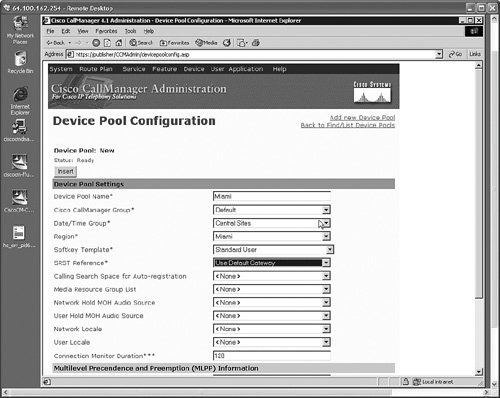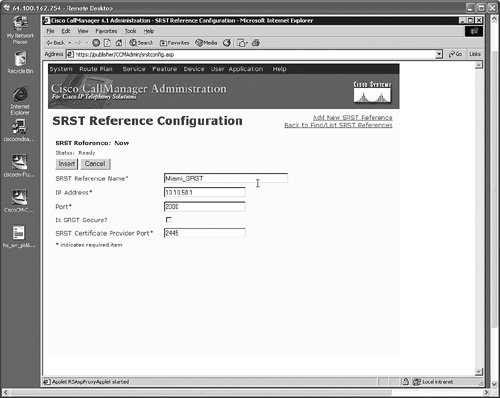Call Flow with MGCP
Configuring SRST
You must configure SRST on the gateway and on CallManager. The CallManager configuration tells the IP phone that an SRST gateway is available. This is normally the tertiary device in the IP phone CallManager list.
Gateway Configuration
You enter SRST configuration mode by using the call-manager-fallback command. At a minimum, you must configure the source address and the number of e-phones and e-phone-dns for the SRST gateway to support. The source address is the IP address that the SRST gateway uses to communicate with the IP phones. Example 13-1 shows the initial SRST configuration.
Miami(config)#call-manager-fallback Miami(config-cm-fallback)#ip source address 10.10.50.1 Miami(config-cm-fallback)#max-ephones 24 Miami(config-cm-fallback)#max-dn 48 |
The max-ephones command specifies how many IP phones can register with the SRST gateway. This value varies by router platform and the license you purchase. The max-dn command specifies how many virtual SRST voice ports are created. The number of DNs is limited by platform and memory; it is not limited to your license. This allows you to maintain multiple lines on your IP phones while in SRST mode. When you enter the max-dn command, the virtual voice ports are created immediately and reside in memory. These virtual voice ports are not saved in the config but are displayed when you enter a show dial-peer voice command, as shown in Example 13-2.
Miami#show dial-peer voice VoiceEncapPeer20001 peer type = voice, information type = voice, description = `', tag = 20001, destination-pattern = `', answer-address = `', preference=0, CLID Restriction = None CLID Network Number = `' CLID Second Number sent CLID Override RDNIS = disabled, source carrier-id = `', source trunk-group-label = `', target trunk-group-label = `', numbering Type = `unknown' group = 20001, Admin state is up, Operation state is down, incoming called-number = `', connections/maximum = 0/unlimited, DTMF Relay = disabled, URI classes: Destination = huntstop = enabled, in bound application associated: 'DEFAULT' out bound application associated: '' dnis-map = permission :both incoming COR list:maximum capability outgoing COR list:minimum requirement Translation profile (Incoming): Translation profile (Outgoing): incoming call blocking: translation-profile = `' disconnect-cause = `no-service' advertise 0x40 capacity_update_timer 25 addrFamily 4 oldAddrFamily 4 type = pots, prefix = `', forward-digits 0 session-target = `', voice-port = `50/0/1', direct-inward-dial = disabled, digit_strip = enabled, register E.164 number with H323 GK and/or SIP Registrar = TRUE fax rate = system, payload size = 20 bytes supported-language = '' Time elapsed since last clearing of voice call statistics never Connect Time = 0, Charged Units = 0, Successful Calls = 0, Failed Calls = 0, Incomplete Calls = 0 Accepted Calls = 0, Refused Calls = 0, Last Disconnect Cause is "", Last Disconnect Text is "", Last Setup Time = 0. |
To limit the impact on the gateway, you should determine how many lines you actually need rather than configure the maximum possible. You can also use the limit-dn command to limit the number of DNs that can register per IP phone type. For example, if your 7960s have four lines, you might choose just to have the primary DN register with the SRST router to conserve resources. Table 13-1 lists the maximum number of e-phones and e-phone-dns supported in currently available platforms. Verify these numbers on Cisco.com, because they might change with new Cisco IOS versions or increases in router CPU or memory capabilities.
|
Router Platform |
Max E-Phones |
Max E-Phone-dns |
|---|---|---|
|
1751-V |
24 |
144 |
|
1760, 1760-V |
24 |
144 |
|
2600XM |
36 |
144 |
|
2650XM, 2651XM |
48 |
192 |
|
2691 |
72 |
288 |
|
2801 |
24 |
256 |
|
2811 |
36 |
144 |
|
2821 |
48 |
192 |
|
2851 |
96 |
288 |
|
3725 |
144 |
960 |
|
3745 |
480 |
960 |
|
3825 |
336 |
960 |
|
3845 |
720 |
960 |
|
CMM |
480 |
800 |
CallManager Configuration
You must specifically configure an IP phone with an SRST reference for it to attempt to register with a gateway. You configure the SRST reference in the device pool. In most implementations, the SRST gateway is also the default gateway for the IP phones. In this situation, you can select Use Default Gateway in the device pool configuration. Figure 13-2 shows the device pool configuration for the Miami phones.
Figure 13-2. Configuring SRST Reference to Use Default Gateway

If the SRST gateway is not the default gateway for the IP phones, you must create an SRST reference that contains the IP address of the SRST gateway. You do this under the System>SRST menu option. Figure 13-3 illustrates an SRST reference configuration.
Figure 13-3. Creating an SRST Reference

If the number of IP phones at a remote site exceeds the capability of the SRST gateway, you can control which IP phones register by creating two device pools for the site. Configure one device pool with an appropriate SRST reference, and assign it to the IP phones that should register with the SRST gateway. Configure a second device pool with the SRST reference set to Disable. This device pool is assigned to IP phones that are not business critical, such as break room or conference room phones.
Dial Plan Considerations |
Part I: Voice Gateways and Gatekeepers
Gateways and Gatekeepers
- Gateways and Gatekeepers
- The Role of Voice Gateways
- The Role of Voice Gatekeepers
- The Role of IP-to-IP Gateways
- Introduction to Voice Protocols
- Call Control Agents
- Deployment Scenarios
- Case Study: Introduction
- Chapter Review Questions
Part II: Gateways
Media Gateway Control Protocol
- Media Gateway Control Protocol
- Introduction to MGCP
- MGCP Operation
- Call Flow with MGCP
- Dial Plan Considerations
- Implementing MGCP Gateways
- Securing MGCP Gateways
- Troubleshooting Tools
- Case Study: Configuring an MGCP Gateway
- Review Questions
H.323
- H.323
- H.323 Specifications
- H.323 Network Components
- Call Flow
- H.323 Protocol Pros and Cons
- When to Use H.323
- Dial Plan Considerations
- Implementing H.323 Gateways
- Securing H.323 Gateways
- Troubleshooting Tools
- Case Study: Configuring an H.323 Gateway
- Review Questions
Session Initiation Protocol
- Session Initiation Protocol
- Description of SIP
- SIP Call Flow
- SIP Pros and Cons
- When to Use SIP
- Dial Plan Considerations
- Implementing SIP Gateways
- Securing SIP Gateways
- Allowing H.323 to SIP Connections
- Troubleshooting Tools
- Case Study: Configuring SIP Between a Gateway and CallManager 5.x
- Review Questions
Circuit Options
Connecting to the PSTN
- Connecting to the PSTN
- PSTN Circuit Selection Overview
- Analog Trunks
- Digital Trunks
- Case Study: Add an E1 R2 Connection to the Leeds Gateway
- Review Questions
Connecting to PBXs
- Connecting to PBXs
- Analog Trunks
- Digital Trunks
- Configuring Transparent Common Channel Signaling
- Case Study: Implementing a Cisco Voice Gateway at the Shanghai Office
- Review Questions
Connecting to an IP WAN
- Connecting to an IP WAN
- Applications for Connecting to an IP WAN
- Design Considerations
- Quality of Service
- Providing Fax and Modem Services
- Security
- Case Study: Using a T1 Link as a Tie Line
- Review Questions
Dial Plans
- Dial Plans
- Numbering Plans
- Overlapping Numbering Plans
- Building a Scalable Dial Plan
- Dial Peers
- Dial Peer Matching
- Case Study: Configuring PSTN Access
- Review Questions
Digit Manipulation
- Digit Manipulation
- Basic Digit Manipulation
- Number Expansion
- Voice Translation Rules and Profiles
- Manipulating Caller ID
- Order of Operation in Digit Manipulation
- Troubleshooting Digit Manipulation
- Case Study
- Review Questions
Influencing Path Selection
- Influencing Path Selection
- Hunt Groups
- Using Trunk Groups
- Tail-End Hop-Off
- Call Admission Control
- POTS-to-POTS Call Routing Considerations
- Case Study: Implementing Gateway-Controlled RSVP
- Review Questions
Configuring Class of Restrictions
- Configuring Class of Restrictions
- COR Overview
- COR Operation
- Implementing COR
- Assigning COR Lists with SRST
- Assigning COR Lists with Cisco CallManager Express
- Restricting Inbound Calls
- Case Study: Implementing COR for Miami
- Review Questions
SRST and MGCP Gateway Fallback
- SRST and MGCP Gateway Fallback
- SRST Overview
- Configuring SRST
- Dial Plan Considerations
- SRST Features
- SIP SRST
- Call Preservation
- Secure SRST
- MGCP Gateway Fallback
- Configuring MGCP Gateway Fallback
- Verifying and Troubleshooting SRST
- Verifying and Troubleshooting MGCP Gateway Fallback
- Case Study: Integrating SRST with an Analog Voice-Mail System
- Review Questions
DSP Resources
- DSP Resources
- Need for DSP Resources
- Determining the DSP Resources Required
- Configuring DSP Resources
- Transcoding for CallManager Express
- Case Study: Add DSP Resources to the Miami Gateway
- Review Questions
Using Tcl Scripts and VoiceXML
- Using Tcl Scripts and VoiceXML
- Tcl IVR and VoiceXML Application Overview
- Sample Applications
- Downloading Tcl Scripts from Cisco.com
- Configuring the Gateway to Use a Tcl Script
- Implementing the AA Tcl Script
- Creating Audio Files
- Restrictions and Caveats
- Case Study: Implementing ACD Application
- Review Questions
Part III: Gatekeepers
Deploying Gatekeepers
- Deploying Gatekeepers
- Gatekeeper Functionality
- Gatekeeper Signaling
- E.164 Number Resolution
- Call Admission Control
- Gatekeeper Deployment Models
- Gatekeepers with CallManager
- Security with Gatekeepers
- Review Questions
Gatekeeper Configuration
- Gatekeeper Configuration
- Configuring Basic Gatekeeper Functionality
- Multiple Gatekeeper Configurations
- Configuring Directory Gatekeepers
- Troubleshooting Gatekeepers
- CallManager and Gatekeepers
- Gatekeeper Redundancy
- Configuring Resource Availability Indicator
- Configuring Gatekeeper Security
- Case Study: Deploying Gatekeepers to Assist in Migration to VoIP
- Review Questions
Part IV: IP-to-IP Gateways
Cisco Multiservice IP-to-IP Gateway
- Cisco Multiservice IP-to-IP Gateway
- IP-to-IP Gateway Overview
- Cisco Multiservice IP-to-IP Gateway
- Basic Configuration
- IP-to-IP Gateway Features
- Case Study: Providing Enterprise VoIP Trunking to VoIP Service of the Service Provider
- Review Questions
Appendix A. Answers to Chapter-Ending Review Questions
Index
EAN: 2147483647
Pages: 218
